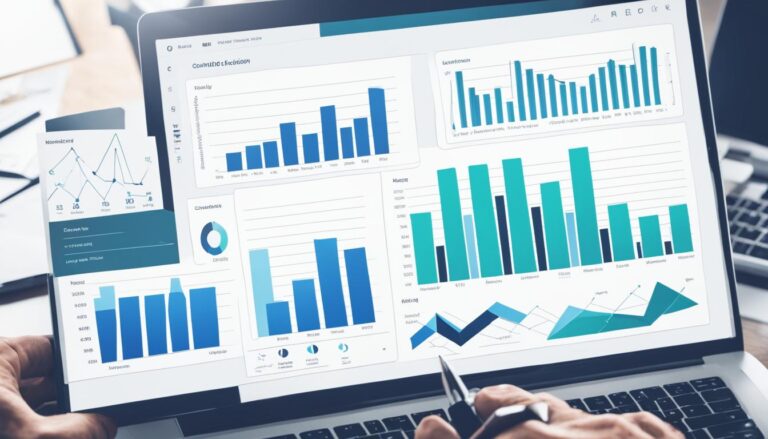R Programming in Finance
In the domain of finance, utilizing R Programming can be a game-changer. The versatility and robustness of R when applied to financial tasks are truly unmatched.
When it comes to making informed decisions, staying ahead of market trends, and optimizing strategies, R has become a staple tool for professionals in the financial sector.
But why has R gained such popularity, and how can it specifically benefit your financial analyses and operations? Let's explore the key reasons why R Programming has become an important asset in the world of finance.
Key Takeaways
- R revolutionizes financial data analysis and decision-making.
- Advanced statistical modeling tools enhance financial forecasting.
- R enables efficient risk management and portfolio optimization.
- Extensive visualization and time series analysis capabilities empower finance professionals.
Why R Programming in Finance?
Utilizing R programming in finance offers a robust analytical framework to efficiently handle complex financial data and models. R programming applications within the finance sector have become increasingly prevalent due to its versatility and powerful statistical capabilities. The integration of R in the finance industry has revolutionized the way professionals analyze data, build models, and make strategic decisions.
In finance, R programming applications enable professionals to perform tasks such as risk management, portfolio optimization, algorithmic trading, and financial forecasting with precision and speed. The flexibility of R allows for the seamless integration of various data sources, making it an ideal tool for handling the vast amount of data prevalent in the financial sector. The extensive library of packages available in R provides a wide range of specialized functions tailored to financial analysis.
The finance industry integration of R programming has enhanced efficiency, accuracy, and decision-making processes. By leveraging the capabilities of R, financial professionals can gain deeper insights into market trends, risks, and opportunities, ultimately leading to more informed and strategic financial decisions.
Advantages of R in Finance
When considering the advantages of R in finance, you must acknowledge its robust data analysis capabilities and its arsenal of statistical modeling tools. These features enable you to perform complex financial analyses efficiently and accurately, enhancing decision-making processes.
Utilizing R in finance empowers you to leverage cutting-edge statistical methods to gain unique insights into market trends and investment opportunities.
Data Analysis Capabilities
R's robust data analysis capabilities make it a powerful tool for financial professionals seeking to extract insights and make informed decisions. In portfolio optimization, R's ability to handle large datasets, perform complex calculations, and visualize results provides a significant advantage.
For algorithmic trading, R's extensive library of packages for statistical analysis, machine learning, and time series analysis allows for the development of sophisticated trading strategies. Its flexibility in handling different data formats, such as CSV, Excel, and SQL databases, makes it versatile for financial data analysis tasks.
Additionally, R's integration with other programming languages and tools enhances its utility in finance. Overall, R's data analysis capabilities equip finance professionals with the tools needed to navigate complex financial markets efficiently.
Statistical Modeling Tools
In the domain of finance, harnessing R for statistical modeling empowers professionals to leverage advanced analytical tools for strategic decision-making and risk management.
Utilizing R for regression analysis allows for precise identification of relationships between variables, aiding in forecasting stock prices and market trends.
Portfolio optimization in R enables the construction of diversified investment portfolios that minimize risk while maximizing returns, providing a competitive edge in the financial landscape.
Additionally, R's flexibility in handling large datasets guarantees efficient processing of vast amounts of financial information, facilitating quicker and more informed investment decisions.
Embrace R for statistical modeling in finance to access unparalleled insights and drive superior outcomes.
Data Analysis With R
When analyzing financial data with R, you'll explore various data visualization techniques to present information effectively.
You'll utilize statistical analysis methods to derive insights and make informed decisions based on the data.
Additionally, you'll employ financial modeling approaches to predict future trends and assess risk in the financial markets.
Data Visualization Techniques
Explore various data visualization techniques in R for effective analysis and interpretation of financial data. When working with financial data in R, consider leveraging interactive plots and geospatial analysis to gain valuable insights.
Here are three key visualization techniques to enhance your financial data analysis:
- Interactive plots: Engage with your data dynamically, allowing for deeper exploration and understanding.
- Geospatial analysis: Visualize financial data on maps to uncover geographical patterns and trends.
- Time series visualization: Track financial metrics over time to identify patterns, cycles, and anomalies effectively.
Utilizing these techniques won't only enhance your data analysis but also provide a clearer picture of the financial landscape.
Statistical Analysis Methods
Consider utilizing statistical analysis methods in R for robust data analysis and insightful decision-making in finance.
Hypothesis testing techniques like t-tests, ANOVA, and chi-square tests are invaluable for evaluating relationships and making inferences about financial data.
Regression analysis methods, such as linear regression, logistic regression, and time series analysis, are essential for understanding the relationships between variables, forecasting trends, and making predictions in finance.
R provides a wide range of functions and packages for conducting these analyses efficiently and accurately.
Financial Modeling Approaches
For robust data analysis and informed decision-making in finance, implementing financial modeling approaches using R can provide valuable insights and enhance predictive capabilities. When delving into financial modeling, two key techniques stand out:
- Monte Carlo simulations: By running numerous simulations with varied inputs, you can assess a wide range of possible outcomes and their probabilities, aiding in risk management and decision-making.
- Portfolio optimization: Utilizing mathematical algorithms to construct portfolios that offer the best possible returns for a given level of risk, thereby optimizing investment strategies.
- Sensitivity analysis: Examining how changes in variables impact the model's outputs, helping to identify critical factors and potential risks in financial decision-making.
These methods empower you to make data-driven choices and enhance your financial strategies.
Visualization Capabilities in R
With its powerful libraries and functions, R offers extensive visualization capabilities that are essential for analyzing financial data. R provides a wide range of tools for creating interactive plots and advanced graphics that aid in interpreting complex financial information. Interactive plots allow you to manipulate data dynamically, zoom in on specific details, and enhance user engagement. R's Shiny package is particularly useful for building interactive dashboards that can be shared and accessed online.
In addition to interactive plots, R boasts advanced graphics that enable the creation of visually appealing and informative charts, such as heatmaps, candlestick charts, and correlation matrices. These advanced graphics help in identifying trends, patterns, and relationships within financial data, facilitating better decision-making processes. R's ggplot2 package is widely used for producing customizable, publication-quality visualizations that enhance the presentation of financial insights.
R in Risk Management
R plays a crucial role in evaluating and managing risks effectively in finance. When it comes to risk management, R provides powerful tools that aid in risk assessment and portfolio optimization. Here are three key aspects where R excels in risk management:
- Advanced Risk Assessment:
R offers a wide range of packages and functions that allow for sophisticated risk assessment techniques. From value-at-risk calculations to stress testing, R enables you to assess risk with precision and depth.
- Efficient Portfolio Optimization:
With R's optimization libraries, you can construct portfolios that strike the right balance between risk and return. By utilizing modern portfolio theory and efficient frontier analysis, R helps in creating optimized portfolios tailored to your risk preferences.
- Scenario Analysis Capabilities:
R enables you to conduct scenario analysis to evaluate the impact of different risk factors on your portfolio. Through scenario simulations, you can assess how your investments may perform under various market conditions, enhancing your risk management strategies.
Time Series Analysis With R
Time series analysis forms a fundamental component of financial data analysis and is a key technique for understanding and forecasting market behavior. In R, conducting time series forecasting and market trends analysis involves utilizing various statistical methods and models to analyze historical data patterns and make informed predictions about future market movements. Time series forecasting in R typically includes techniques such as autoregressive integrated moving average (ARIMA), exponential smoothing methods, and machine learning algorithms like recurrent neural networks.
Market trends analysis with R involves examining historical price movements, trading volumes, and other relevant financial indicators to identify patterns and trends that may help in making investment decisions. By using R packages such as 'xts' and 'quantmod', you can efficiently manipulate and visualize financial time series data to gain insights into market dynamics and potential future outcomes. Overall, mastering time series analysis with R equips you with the tools needed to navigate complex financial markets and make data-driven investment choices.
Financial Modeling in R
Financial modeling in R enhances decision-making processes by allowing for thorough analysis and simulation of various financial scenarios. When utilizing R for financial modeling, you can leverage powerful tools like Monte Carlo simulations and portfolio optimization to gain valuable insights into your investments.
Here are three key aspects to contemplate:
- Risk Management: Implement Monte Carlo simulations to assess the impact of uncertainty on your investment strategies, enabling you to make more informed decisions.
- Diversification Strategies: Utilize portfolio optimization techniques to construct well-balanced investment portfolios that maximize returns while minimizing risks.
- Scenario Analysis: Conduct scenario analysis using financial modeling in R to evaluate how different market conditions can affect your investment performance, helping you to proactively adjust your strategies.
R Packages for Finance
Enhancing your financial analysis capabilities through the utilization of specialized packages in R can greatly streamline your data processing and modeling tasks. In the domain of finance, R offers a wide array of packages tailored to specific needs, such as portfolio optimization and algorithmic trading.
For portfolio optimization, packages like 'PortfolioAnalytics' and 'fPortfolio' provide tools to construct and analyze investment portfolios. These packages offer functions for efficient frontier calculations, risk assessment, and asset allocation strategies. By leveraging these packages, you can enhance your portfolio management decisions and maximize returns while managing risks effectively.
When it comes to algorithmic trading, R offers packages like 'quantmod' and 'xts' that enable you to develop and backtest trading strategies. These packages include functions for technical analysis, strategy implementation, and performance evaluation. Utilizing these tools can help you automate trading processes, exploit market inefficiencies, and improve trading outcomes.
Getting Started With R in Finance
Incorporate R into your finance workflow by exploring its powerful capabilities for data analysis and modeling. R offers a wide range of tools and packages that can help you explore into various financial aspects effectively.
When starting with R in finance, consider the following:
- Portfolio Optimization: Utilize R to analyze and optimize your investment portfolios. R provides functions and libraries that can assist in constructing efficient portfolios tailored to your risk-return preferences.
- Algorithmic Trading: Leverage R's computational capabilities to develop and backtest trading algorithms. With R, you can implement complex trading strategies, conduct statistical analysis, and automate the trading process.
- Data Visualization: Visualize financial data using R's advanced plotting libraries. Create interactive graphs, charts, and dashboards to gain insights into market trends, portfolio performance, and risk analysis.
Conclusion
To sum up, R programming offers a robust set of tools for financial analysis, modeling, and risk management. Are you prepared to harness the power of R to enhance your financial decision-making processes?
With its data analysis capabilities, visualization tools, and specialized packages for finance, R is a valuable asset for professionals in the finance industry.
Immerse yourself in R programming today and reveal a world of possibilities for your financial analysis needs.







